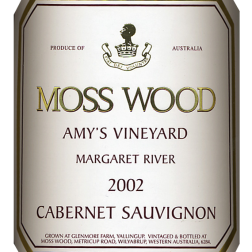Moss Wood 2002 Amy’s Amy’s Vineyard
Wine Facts
Blend: Cabernet Sauvignon 95% Merlot 5%
| Harvested: | 10/2/2002 |
| Bottled: | 22/8/2003 |
| Released: | 16/10/2003 |
| Alcohol | 14.00% |
SOLD OUT
Tasting Notes
The Moss Wood 2002 Amy's Vineyard Cabernet Sauvignon has a style typical of the vintage with vibrant fruit aromas, something which is a feature of Yallingup wines but really comes to the fore in such a mild year. The nose shows dark fruits of redcurrants and blueberries as well as some complex earthy notes not seen before, which we attribute to the inclusion of Merlot (about 5%) in the blend for the first time. There is also soft, toasty oak.
On the palate, the wine also displays its 'regionality' with clear blueberry flavours filling the front and midpalate. The structure is firm with high acidity and assertive tannins, although both are balanced by excellent length of flavour.
Moss Wood 2002 Amy’s – Ray Jordan,The West Australian
Vintage Notes
Customers who have followed Moss Wood wine over the years know this wine by its former name, the Glenmore Vineyard Cabernet Sauvignon. The grapes for this wine are sourced from the Glenmore Vineyard at Yallingup, which belongs to Ian Bell, who worked at Moss Wood from 1985 to 2006.
Ian has been producing wine from his vineyard since the 2000 vintage and this year will release his own "Glenmore" label for the first time. To avoid confusion between the two wines, the Moss Wood product has a new name - Amy's Vineyard, in honour of Ian's grandmother, Glenmore farm owner and Yallingup legend, Amy Beers.
Production Notes
Production techniques were as per the normal recipe, with all fruit hand picked and then de-stemmed into open fermenters. Each batch was then seeded with a pure yeast culture and hand plunged four times per day for extraction. Fermentation temperature was set at a maximum of 30°C. The wine was on skins for an average of 12 days and then it was pressed. All pressings were included and then the wine was racked into barrel for malolactic fermentation. It spent 12 months in French oak barriques, of which 33% were new. Finally, the wine was filtered and then bottled in August 2003.
Cellaring Notes
With such bright fruit characters, the wine appeals for early drinking but it has excellent cellaring potential and can be kept for at least five more years. The earliest of these wines, the 1997, is still sound and continues to improve in bottle.

